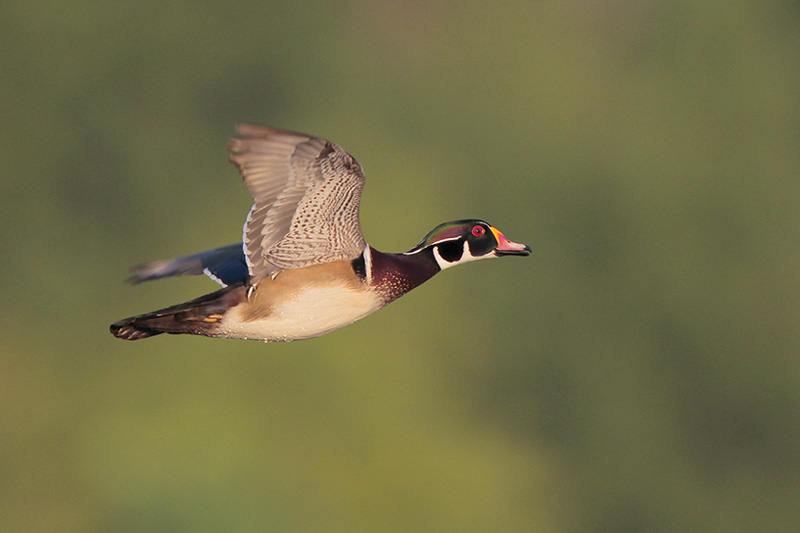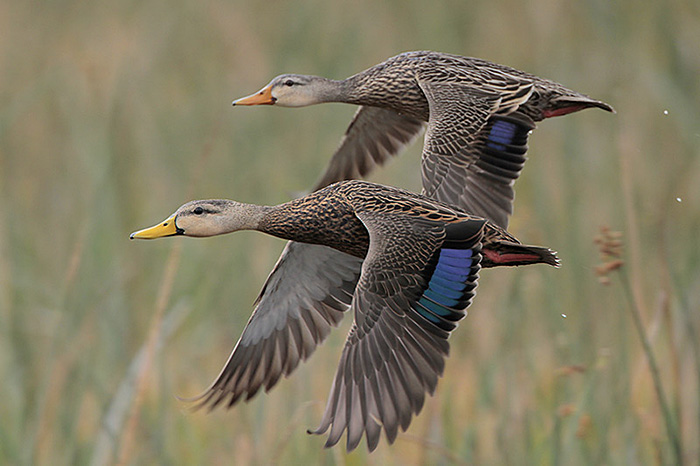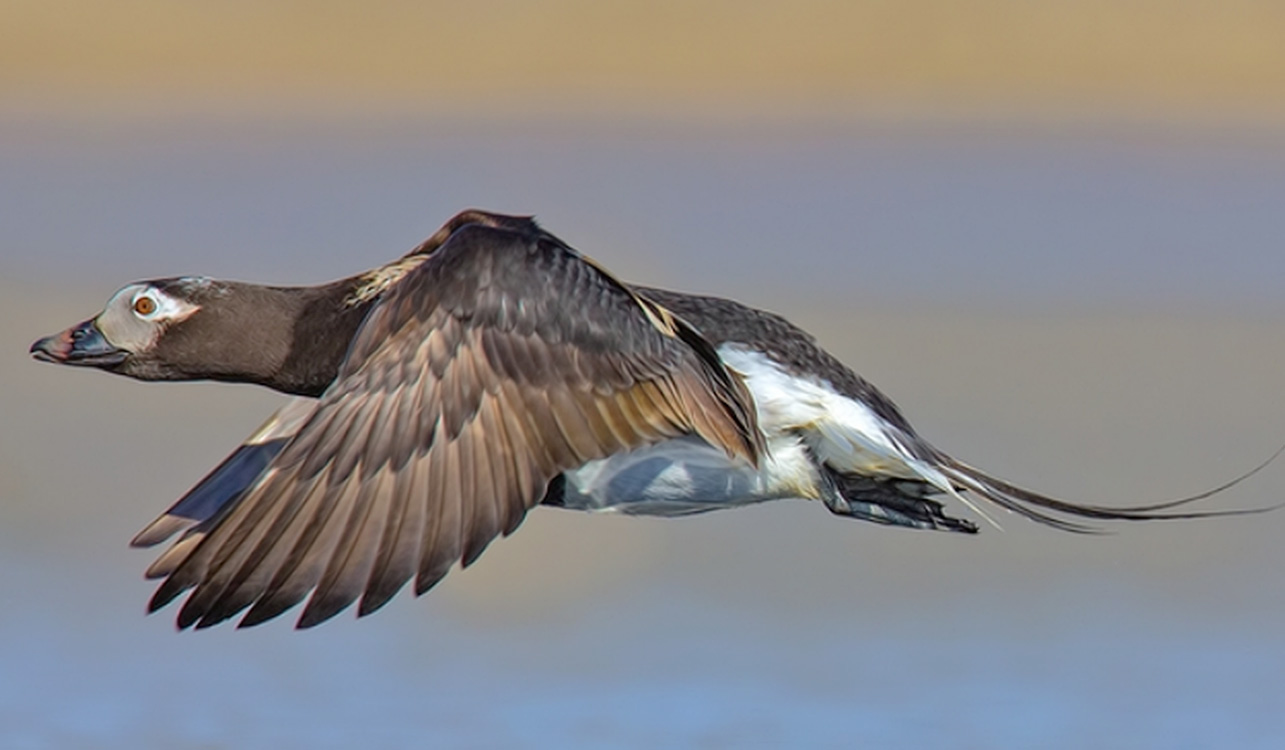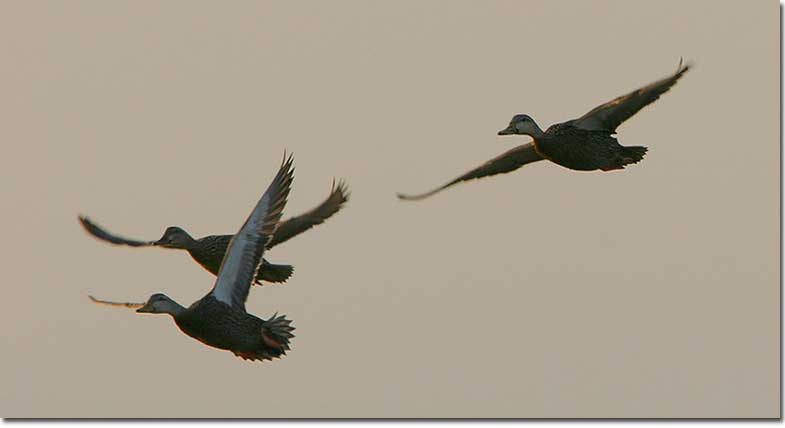
Can ducks fly? When we see flocks of ducks and geese migrating through autumn skies and witness ducks bursting into flight from a pond, it might seem strange to ask that question.
However, no matter how flightworthy ducks may seem to be, there are valid reasons for wondering if ducks can fly.
Although most wild duck species fly very well, there are also some flightless duck species and breeds, and, all species of ducks, geese, swans, and related waterfowl are flightless for a few weeks of every year.
On this page
Can All Ducks Fly?
Most ducks can fly but not all of them. Most of the domestic duck breeds, or “farm ducks” are incapable of flight, including the familiar American Pekin or Long Island Duck, a brilliant white duck with an orange bill often seen on farms and kept as pets.
Other flightless domestic duck breeds include the handsome Buff Duck, the cute Ancona Duck, the hefty Indian Runner Duck, and the beautiful, dark, glossy green Cayuga Duck.
These and other domestic duck breeds have lost the ability to fly because they have been bred to become flightless and are used for food, to produce eggs, and be pets.
Although they can flap their wings, the wings and/or feathers are too short for flight, some lack the strong and developed muscles required for flight, and most are just too heavy to get off the ground.
Amazingly, there are also some wild duck species that can’t fly. In southern Argentina and Chile, we find three species of flightless Steamer Ducks that only use their short wings to propel them across the surface of the water, and there are two species of endangered flightless Teal found in some parts of New Zealand.
Related: What do ducks symbolize?
All other species of swans, geese, and ducks can fly but not for the entire year. For a couple weeks between May and July, they lose the ability to fly when they molt or change their feathers, including the ones needed for flight. During that vulnerable time of the year, they spend more time on the water or hidden in dense vegetation.
How Do Ducks Fly?
Ducks are well built for flying. They have an aerodynamic and contoured body shape and feathers that help them cut through the air with ease, strong breast muscles to quickly move their wings, and long, pointed wings perfectly adapted for fast flight.

Photograph © Greg Lavaty.
Ducks take flight in one of two ways. Mallards and other dabbling ducks leap straight into the air by using their wings to push down on the surface of the water.
Diving ducks like the Bufflehead, Scaup, and other species become airborne by running along the surface of the water while beating their wings. Either way, when ducks take flight, they quickly pick up speed to fly fast and straight to their destinations.
To take to the air, ducks beat they wings very fast, as much as ten beats per second. Most duck species, and especially ones that live in open waters, like the Scoters, Eiders, and Scaups, tend to fly low over the water as they migrate over large lakes and along coastlines.
During migration, most species tend to fly below 500 feet but, when necessary, Mallards and many other ducks can also fly at high elevations.
See more: 12 Facts About Ducks
The high-flying capabilities of the Ruddy Shelduck and Bar-headed Goose are nothing short of incredible. While migrating from Tibet and Mongolia to India, these species routinely fly more than 20,000 feet high as they cross the Himalayan Mountains.
How Far Can Ducks Fly?
When ducks want to, they can fly for very long distances without stopping. Although they often fly short distances from one feeding area to the next, during migration, many species can fly for hundreds of miles without taking a break. One Northern Pintail was tracked flying for nearly 2,000 miles before it landed!

Several other species are also long-distance migrants that fly from the Arctic and boreal forests of Canada to California, coastal Texas, Mexico, and further south. Some Blue-winged Teals fly from North America all the way to Venezuela and Peru.
The common and familiar Mallard can also migrate for long distances with some having been recorded using fast tail winds to help them fly 800 miles in just eight hours.
How Fast Can Ducks Fly?
In general, ducks are fast flying birds. They have evolved fast and direct flight to migrate long distance and avoid falcons that prey on them. Although Muscovy Ducks, geese, and swans fly fairly slow with deep, steady wing beats, the wings of ducks are too long and their wing beats too quick to fly at a slow or maneuverable pace.
Related: What is a group of ducks called?
Most duck species fly anywhere from 40 to 60 miles per hour shortly after takeoff and can cruise at that speed for long distances.

The Mallard is one such bird and often flies 50 miles per hour, at least during migration. Another fast flyer, the Canvasback, has been clocked at 70 miles per hour. That is quick but the fastest speed recorded for any duck was a Red-breasted Merganser that reached a speed of 100 miles per hour while being chased by a plane.
Although Blue-winged Teal and Green-winged Teal may seem to fly fast, with an average speed of 30 miles per hour, they are actually some of the slower duck species.
Frequently Asked Questions
Do all Call Ducks fly?
Yes. Most Call Ducks fly very well but usually return to their home.
Why can’t all ducks fly?
Most domestic ducks have lost the ability to fly because they have been bred to be flightless and used for food, eggs, and pets.
Some other wild duck species have also become flightless because they evolved on predator-free islands or spend nearly all of their time on the water. All ducks also become flightless when they molt their feathers.
Do ducks get tired of flying?
Ducks can get tired of flying, but usually after flying for several hours at a time.

